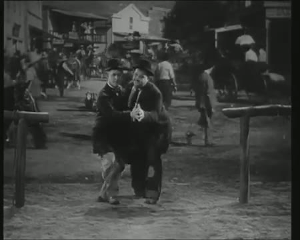He Leads... She Follows. Really?

If you have been reading the ads and publicity spots, watching infomercials, or visiting dance schools, you have seen and/or heard forever that the man leads and the lady follows. I have often heard women say, "I'm a great dancer, as long as I have a good lead". Carlos Gavito, the late, great maestro of the Argentine Tango , once said [and, only half jokingly], "If she blinks her eyes... I led that, too".
At DanceKinesis, we teach that dance movement is all about the follow. As for those ladies who demand that they have a good lead in order to make them be "great dancers", I have often said that I do not enjoy dancing with these persons as much as some others, and for 2 basic reasons; 1- I do not want to dance for the lady; I want to dance with the lady, and -2- If I am having to lead every movement that she dances, then one of us is dancing while the other is working. We understand that Gavito was jesting. We do not, nor wish to have to, lead every step and every movement of the dance.
I Never Lead the Lady
My clients hear this often. In fact, there have been many discussions at the council levels about the terminologies and understandings (or, misunderstandings) of "lead and follow". It is fairly accepted that the term lead refers to the man deciding what it is that he wishes to have the lady to dance, and then, doing certain things to manifest same. Further, that the term follow indicates that the lady has understood the man's directive/s and acts or reacts accordingly. DanceKinesis challenges these concepts greatly. We teach that the man's role is not to 'lead' the lady at all. We teach that the his role is akin to that of a traffic cop... to direct and redirect the flow of traffic.If he were to lead at all, it would be that he leads 'himself'.
As an example, let's look at the American Foxtrot basic pattern called the Quick Promenade. This pattern is formed by the man dancing 2 slow forward steps beginning with the left foot, and changing both direction and timing by dancing 2 more forward steps in a promenade position to his left, and with a slightly quicker movement. Most refer to this movement as "Slow ,Slow, Quick, Quick", but that's fodder for another trough. The man will not push, lift, apply pressures to, or place the lady into the back walks. He simply; stands tall (properly stacking the 3 body triangles), and places his weight balanced over the arches of his feet (his center axis). When he is ready to dance, he moves himself forward toward the toes. The lady, being properly balanced in the dance position, will sense/feel this movement coming toward her, and swing accordingly out of the way. At Step 3, the man will not 'lead' the lady to promenade. He will, again, lift and rotate his core slightly rightward, and continue the movement. He has, in this moment, 1- lead himself... not the lady, and -2- redirected the former movement to another direction... like a traffic cop.
One can make the argument that the man led the lady by doing what he did (leaning into the movement, and/or lifting/rotating his body and changing directions). However, we maintain that he 'does nothing' to the lady, but with himself. If there were a lead at all, it would be that the lady leads the man.
The Lady Should Never Follow The Man
By definition, a person who will lead will be in an up-front position, thus allowing the follow to do so subsequently, or from behind. DK teaches that although the man is dancing forward, it is the lady who is leading because she is the person in the front of the partnership. The man puts himself in motion. the lady then leads by creating a space for the man to move into. If she does not, his motion stops. If she takes a shortened step, then his movement is limited. if she takes a long and swinging step, then the man may move more gracefully and in longer strides. It's all up to her! She is in essence leading.
But, It's All About the Follow
Lastly, DanceKinesis teaches that the most important role for both the man and the woman is to follow. You can imagine the "stink-eyes" and all-out arguments that this theory causes, especially among the authentic tango dancers. Yet, the concept and understanding is quite simple when one is amiable to letting go of stereotypes, old beliefs, and old paradigms. Consider the example above. The man places his body into a forward motion. The lady moves accordingly as a body is coming toward her. She is in fact 'following' the movement...not the man. She is also leading by creating the dance space for the movement to continue. This allows the man to 'follow' --not the lady, but his own initiated by leaning movement. so, one sees, that both partners must follow the dance, rather than try to lead a partner or an action.
He does not lead the lady. She does not follow the man. He initiates a movement and follows that movement to the end of its ability. She follows, not the man, but the movement created The man concludes the action by following the woman to the end of its natural momentum. He might, at that point, continue or redirect his own intention, allowing the cycle of following to begin again.
In the mid 1980s, the renowned Peter Eggleton introduced a Round and Body School movement concept which he referred to Ball and Ruler. DanceKinesis studied, developed, and furthered this concept throughout movement and as the basis for Flight in Leading and Following.






